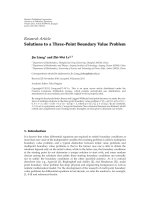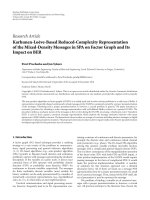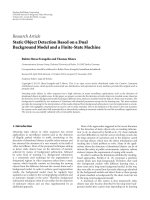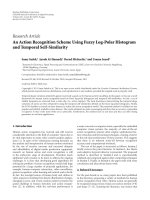Báo cáo hóa học: " Research Article Human Gait Recognition Based on Multiview Gait Sequences" doc
Bạn đang xem bản rút gọn của tài liệu. Xem và tải ngay bản đầy đủ của tài liệu tại đây (1.27 MB, 8 trang )
Hindawi Publishing Corporation
EURASIP Journal on Advances in Signal Processing
Volume 2008, Article ID 629102, 8 pages
doi:10.1155/2008/629102
Research Article
Human Gait Recognition Based on Multiview Gait Sequences
Xiaxi Huang and Nikolaos V. Boulgouris
Department of Electronic Engineering, Division of Engineering, King’s College London WC2R2LS, UK
Correspondence should be addressed to Nikolaos V. Boulgouris,
Received 6 June 2007; Revised 10 October 2007; Accepted 23 January 2008
Recommended by Juwei Lu
Most of the existing gait recognition methods rely on a single view, usually the side view, of the walking person. This paper investi-
gates the case in which several views are available for gait recognition. It is shown that each view has unequal discrimination power
and, therefore, should have unequal contribution in the recognition process. In order to exploit the availability of multiple views,
several methods for the combination of the results that are obtained from the individual views are tested and evaluated. A novel
approach for the combination of the results from several views is also proposed based on the relative importance of each view. The
proposed approach generates superior results, compared to those obtained by using individual views or by using multiple views
that are combined using other combination methods.
Copyright © 2008 X. Huang and N. V. Boulgouris. This is an open access article distributed under the Creative Commons
Attribution License, which permits unrestricted use, distribution, and reproduction in any medium, provided the original work is
properly cited.
1. INTRODUCTION
Gait recognition [1] aims at the identification of individuals
based on their walking style. Recognition based on human
gait has several advantages related to the unobtrusiveness and
the ease with which gait information can be captured. Unlike
other biometrics, gait can be captured from a distant camera,
without drawing the attention of the observed subject. One
of the earliest works studying human gait is that of Johans-
son [2], who showed that people are able to recognize human
locomotion and to identify familiar persons, by presenting a
series of video sequences of different patterns of motion to
a group of participants. Later, Cutting and Kozlowski in [3]
used movinglight displays (MLDs) to further show the hu-
man ability for person identification and gender classifica-
tion.
Although several approaches have been presented for the
recognition of human gait, most of them limit their attention
to the case in which only the side view is available since this
viewing angle is considered to provide the richest informa-
tion of the gait of the waking person [4–7]. In [8], an exper-
iment was carried out using two views, namely, the frontal-
parallel view and the side view, from which the silhouettes of
the subjects in two walking stances were extracted. This ap-
proach exhibited higher recognition accuracy for the frontal-
parallel view than that of the side view. The side view was
alsoexaminedin[9] together with another view from a dif-
ferent angle, and the static parameters, such as the height of
the walking person, as well as distances between body parts,
were used in the template matching. Apart from the recogni-
tion rate, results were also reported based on a small sample
set using a confusion metric which reflects the effectiveness
of the approach in the situation of a large population of sub-
jects. The authors in [10] synthesize the side view silhouettes
from those captured by multiple cameras employing visual
hull techniques. In [11], the perspective projection and op-
tical flow-based structure of motion approach was taken in-
stead. In [12], information from multiple cameras is gathered
to construct a 3D gait model.
Among recent works, the authors in [13]useimproved
discriminant analysis for gait recognition, the authors in [14]
use information of gait shape and gait dynamics, while the
authors in [15] use a gait energy image (GEI). However, all
above approaches are based only on side view sequences.
In this paper, we use the motion of body (MoBo)
database from the Carnegie Mellon University (CMU) in or-
der to investigate the contribution of each viewing direction
to the recognition performance of a gait recognition system.
In general, we try to answer the fundamental question: if sev-
eral views are available to a gait recognition system, what is
the most appropriate way to combine them in order to enhance
the performance and the reliability of the system? We prov id e
2 EURASIP Journal on Advances in Signal Processing
a detailed analysis of the role and the contribution of each
viewing direction by reporting recognition results of systems
based on each one of the available views. We also propose a
novel way to combine the results obtained from different sin-
gle views. In the proposed approach, we set a weight for each
view, based on its importance as it is calculated using statis-
tical processing of the differences between views. The exper-
imental results demonstrate the superior performance of the
proposed weighted combination approach in comparison to
the single-view approach and other combination methods
for multiple views.
The paper is organized as follows. Section 2 presents the
recognition performance of individual views in a multiview
system. The proposed method for the combination of dif-
ferent views is presented in Section 3. Section 4 reports the
detailed results using the proposed approach for the com-
bination of several views. Finally, conclusions are drawn in
Section 5.
2. GAIT RECOGNITION USING MULTIPLE VIEWS
The CMU MoBo database does not contain explicitly the ref-
erence set and the test sets as in [5]. In this work, we use
the “fast walk” sequences as the reference set, and the “slow
walk” sequences as the test set. As mentioned in the introduc-
tion, our goal is to find out which viewing directions have the
greatest contribution in a multiview gait recognition system.
To this end, we adopt a simple and straightforward way in or-
der to determine the similarity between gait sequences in the
reference and test databases. Specifically, from each gait se-
quence, taken from a specific viewpoint, we construct a sim-
ple template T by averaging all frames in the sequence
T
=
1
N
T
N
T
a=1
t
a
,(1)
where t
a
, a = 1, ,N
T
, are the silhouettes in a gait sequence
and N
T
is the number of silhouettes. This approach for tem-
plate construction was also taken in [15–17].
Let T
i
, R
j
denote the templates corresponding to the ith
and the jth subjects in the test database and the reference
database, respectively. Their distance is calculated using the
following distance metric:
d
T
i
, R
j
=
T
i
− R
j
=
1
N
T
i
N
T
i
α=1
t
iα
−
1
N
R
j
N
R
j
β=1
r
jβ
,(2)
where
·is the l
2
-norm and t
iα
, r
jβ
are the silhouettes be-
longing to the ith test subject and jth reference subject, re-
spectively. The associated frame indices α and β run from
1 to the total number of silhouettes in a sequence (N
T
i
and
N
R
j
, resp.). Essentially, a template is produced for each sub-
ject by averaging all silhouettes in the gait sequence. Specifi-
cally, the Euclidean distance between two templates is taken
as a measure of their dissimilarity. In practice, this means that
a smaller template distance corresponds to a closer match be-
tween two compared subjects.
In order to evaluate the contribution of various viewing
directions in the human gait recognition, we choose MoBo
N
E
SE
S
SW
NW
Rear view
Side view
Frontal view
Figure 1: Camera arrangement in the CMU MoBo database. Six
cameras are oriented clockwise in the east, southeast, south, south-
west, northwest, north, with the walking subject facing toward the
south.
Table 1: The recognition rates of the five viewing directions re-
ported at rank 1 and rank 5.
Camera location Rank 1(%) Rank 5(%)
East 84 92
Southeast 64 76
South 88 96
Northwest 76 92
Southwest 72 76
database [18] from the CMU which contains walking sub-
jects captured from six cameras located in positions as shown
in Figure 1. The database consists of walking sequences of
23 male and 2 female subjects, who were recorded perform-
ing four kinds of activities, that is, fast walk, slow walk, and
so on. Before the application of our methodologies, we use
bounding boxes of silhouettes, then align and normalize all
silhouettes so that they have uniform dimensions, that is, 128
pixels tall and 80 pixels wide, in order to eliminate height
differences of the walking subjects. We use five (see Figure 2)
out of the six available viewing directions, omitting the north
view, since it is practically identical to the south view (i.e., the
frontal view). The cumulative match scores for each of these
five viewing directions are shown in Figure 4, and the recog-
nition rates at rank 1 and rank 5 are reported in Ta bl e 1.
One can see clearly from Ta bl e 1 that the results obtained
using the south and the east viewing directions are the best,
especially at rank 1. Results achieved using the rest of the
viewing directions are worse. This is a clear indication that
the south and the east viewing directions capture most of the
gait information of the walking subjects and, therefore, are
the most discriminant viewing directions. In the next section,
we will show how to combine results from several viewing
directions in order to achieve improved recognition perfor-
mance.
X. Huang and N. V. Boulgouris 3
NW SW S SE E
Figure 2: Available views for multiview gait recognition.
NW SW S SE E
Figure 3: Templates constructed using the five available views.
60
65
70
75
80
85
90
95
100
Percentage
0 5 10 15 20
Rank
Camera E
Camera SE
Camera S
Camera NW
Camera SW
Figure 4: Cumulative match scores for five viewing directions,
namely, the east, southeast, south, southwest, and the northwest.
3. COMBINATION OF DIFFERENT VIEWS USING
A SINGLE DISTANCE METRIC
In this section, we propose a novel method for the combina-
tion of results from different views in order to improve the
performance of a gait recognition system. In our approach,
we use weights in order to reflect the importance of each view
during the combination. This means that instead of using a
single distance for the evaluation of similarity between walk-
ing persons i and j, we use multiple distances between the
respective views and combine them in a total distance which
is given by
D
T
i
, R
j
=
V
v=1
w
v
d
v
T
i
, R
j
,(3)
where V is the total number of available views. Therefore,
our task is to determine the weights w
v
,whichyieldsmaller
total distance when i
= j, and larger when i
/
= j.
Suppose that d
fv
, v = 1, 2, , V, are random variables
representing the distances between a test subject and its cor-
responding reference subjects (i.e., “within class” distance),
and d
bv
, v = 1, 2, ,V, are random variables representing
the distances between a test subject and a reference subject
other than its corresponding subject (i.e., “between class”
distance).
In order to maximize the efficiency of our system, we first
define the distance D
f
between corresponding subjects in the
reference and test databases:
D
f
=
V
v=1
w
v
d
fv
= w
T
· d
f
,(4)
and the weighed distance between noncorresponding sub-
jects:
D
b
=
V
v=1
w
v
d
bv
= w
T
· d
b
. (5)
In an ideal gait recognition system, D
f
should always be
smaller than D
b
. In practice, a recognition error takes place
whenever D
b
<D
f
. Therefore, the probability of error is
P
e
= P
D
b
<D
f
=
P
w
T
· d
b
< w
T
· d
f
=
P
w
T
·
d
b
− d
f
< 0
.
(6)
4 EURASIP Journal on Advances in Signal Processing
We define the random variable z as
z
= w
T
·
d
b
− d
f
(7)
if we assume that d
b
and d
f
are normal random vectors, then
z is a normal random variable with probability density dis-
tribution
P(z)
=
1
√
2πσ
z
e
−(1/2)((z−m
z
)
2
/σ
2
z
)
,(8)
where m
z
is the mean value of z, σ
z
is the variance of z.
Therefore, using (7)and(8), the probability of error in
(6) is expressed as
P
e
= P(z<0) =
0
−∞
1
√
2πσ
z
e
−(1/2)((z−m
z
)
2
/σ
2
z
)
dz. (9)
Furthermore, if q
= (z − m
z
)/σ
z
, then the above expres-
sion is equivalent to
P
e
=
−m
z
/σ
z
−∞
1
√
2π
e
−(1/2)q
2
dq. (10)
The probability of error can therefore be minimized by
minimizing
−m
z
/σ
z
, or equivalently by maximizing m
z
/σ
z
.
To this end, we have to calculate m
z
and σ
z
.IfE{·} denotes
statistical expectation, then the mean value of z is
m
z
= E{z}
=
E
w
T
d
b
− d
f
=
w
T
E
d
b
−
E
d
f
=
w
T
m
d
b
− m
d
f
,
(11)
where m
d
b
and m
d
f
are the mean vectors of d
b
and d
f
.The
variance of z is
σ
2
z
= E
z − m
z
2
=
E
w
T
d
b
− d
f
−
w
T
m
d
b
− m
d
f
2
=
E
w
T
d
b
− m
d
b
−
w
T
d
f
− m
d
f
2
=
E
w
T
d
b
− m
d
b
−
w
T
d
f
− m
d
f
×
d
b
− m
d
b
T
w −
d
f
− m
d
f
T
w
=
E
w
T
d
b
− m
d
b
d
b
− m
d
b
T
w
− w
T
d
b
− m
d
b
d
f
− m
d
f
T
w
− w
T
d
f
− m
d
f
d
b
− m
d
b
T
w
+ w
T
d
f
− m
d
f
d
f
− m
d
f
T
w
.
(12)
If we assume that d
b
and d
f
are independent, then
σ
2
z
= w
T
· E
d
b
− m
d
b
d
b
− m
d
b
T
·
w
+ w
T
· E
d
f
− m
d
f
d
f
− m
d
f
T
·
w
= w
T
· Σ
d
b
· w + w
T
· Σ
d
f
· w.
(13)
Therefore, the optimization problem becomes equivalent
to maximizing
m
2
z
σ
2
z
=
w
T
·
m
d
b
− m
d
f
·
m
d
b
− m
d
f
T
· w
w
T
· Σ
d
b
· w + w
T
· Σ
d
f
· w
=
w
T
· Σ
d
c
· w
w
T
·
Σ
d
b
+ Σ
d
f
·
w
,
(14)
where
Σ
d
c
=
m
d
b
− m
d
f
·
m
d
b
− m
d
f
T
. (15)
The maximization of the above quality is reminiscent of
the optimization problem that appears in two-class linear
discriminant analysis. Trivially, the ratio can be maximized
by determining a vector w that satisfies [19]
Σ
d
c
· w = Λ
Σ
d
b
+ Σ
d
f
· w (16)
for some Λ. In the case that we are considering, the optimal
w is given by
w
=
Σ
d
b
+ Σ
d
f
−1
·
m
d
b
− m
d
f
. (17)
If we assume that the distances corresponding to different
views are independent, then
Σ
d
b
+ Σ
d
f
−1
=
⎛
⎜
⎜
⎜
⎜
⎜
⎜
⎜
⎜
⎜
⎜
⎜
⎜
⎝
1
σ
2
d
b1
+ σ
2
d
f 1
0 ··· 0
0
1
σ
2
d
b2
+ σ
2
d
f 2
··· 0
.
.
.
.
.
.
.
.
.
.
.
.
00
···
1
σ
2
d
bV
+ σ
2
d
fV
⎞
⎟
⎟
⎟
⎟
⎟
⎟
⎟
⎟
⎟
⎟
⎟
⎟
⎠
,
(18)
where V is the total number of available views. Therefore, the
optimal weight vector is
w
=
m
d
b1
− m
d
f 1
σ
2
d
b1
+ σ
2
d
f 1
m
d
b2
− m
d
f 2
σ
2
d
b2
+ σ
2
d
f 2
···
m
d
bV
− m
d
fV
σ
2
d
bV
+ σ
2
d
fV
T
.
(19)
Of course, the practical application of the above theory
requires the availability of a database (other than the test
database) which will be used in conjunction with the refer-
ence database for the determination of m
d
b
, m
d
f
, σ
d
b
, σ
d
f
.In
our experiments, we used the CMU database of individuals
walking with a ball for this purpose.
In the ensuring section, we will use the weight vector in
(19) for the combination of views and the evaluation of the
resulting multiview gait recognition system.
4. EXPERIMENTAL RESULTS
For the experimental evaluation of our methods, we used the
MoBo database from the CMU. The CMU database has 25
X. Huang and N. V. Boulgouris 5
60
65
70
75
80
85
90
95
100
Percentage
0 5 10 15 20
Rank
Mean
Median
Product
Max
Min
Weighed
Figure 5: Cumulative match scores for the proposed and the other
five combination methods.
subjects walking on a treadmill. Although this is an artificial
setting that might affect the results, using this database was
essentially our only option since this is the only database that
provides five views. We used the “fast walk” sequences as ref-
erence and the “slow walk” as test sequences. We also used
the “with a ball” sequences in conjunction with the refer-
ence sequences for the determination of the weights in (19).
The comparisons of recognition performance are based on
cumulative match scores at rank 1 and rank 5. Rank 1 re-
sults report the percentage of subjects in a test set that were
identified exactly. Rank 5 results report the percentage of test
subjects whose actual match in the reference database was
in the top 5 matches. In this section, we present the results
generated by the proposed view combination method. These
results are compared to the results obtained using different
single views and other combination methods.
Initially, we tried several simple methods for the com-
bination of the results obtained using the available views.
Specifically, the total distance between two subjects was taken
to be equal to the mean, max, min, median,andproduct of
the distances corresponding to each of the five viewing di-
rections. Such combination approaches were originally ex-
plored in [20]. As shown in Figure 5 and Tab le 2,amongall
the above combination methods, the most satisfactory results
were obtained by using the Product and Min rules.
In the sequel, we applied the proposed methodology for
the determination of the weights in (3).Basedon(19), the
weights for the combination of the distances of the avail-
able views were calculated and are tabulated in Ta bl e 3.As
seen, the most suitable views seem to be the frontal (east) and
the side (south) views since these views are given the greater
weights.
The above conclusion is experimentally verified by study-
ing the recognition performance that corresponds to each of
the views independently. The cumulative match scores and
60
65
70
75
80
85
90
95
100
Percentage
0 5 10 15 20
Rank
Camera E
Camera SE
Camera S
Camera NW
Camera SW
Weighed
Figure 6: Cumulative match scores for five viewing directions and
the proposed combination method.
Table 2: The recognition rates of the proposed and the other five
combination methods.
Combination method Rank 1(%) Rank 5(%)
Mean 80 92
Median 84 88
Product 88 96
Max 72 80
Min 88 96
Weighed (proposed) 92 96
Table 3: The weights calculated by the proposed method.
View East Southeast South Northwest Southwest
Weight 0.3332 0.0603 0.4036 0.1188 0.0842
Table 4: The recognition rates of the five viewing directions and the
proposed combination method.
View Rank 1(%) Rank 5(%)
East 84 92
Southeast 64 76
South 88 96
Northwest 76 92
Southwest 72 76
Weighed (proposed) 92 96
the recognition rates that are achieved using each view as
well as those achieved by the proposed method are shown in
Figure 6 and Ta b le 4 , respectively. As we can see, the south
and the east views have the highest recognition rates, as
well as the highest weights, which means that the weights
calculated by the proposed method correctly reflect the
6 EURASIP Journal on Advances in Signal Processing
Table 5: The verification rates for the single-view and combined-views methods.
Viewing direction
Verification rate (%)
Combination method
Verification rate (%)
FAR 5% FAR 10% FAR 20% FAR 5% FAR 10% FAR 20%
East 88 96 96 Mean 88 92 96
Southeast 68 72 76 Median 92 94 96
South 9296100 Product 9296 96
Northwest 80 92 92 Max 72 76 84
Southwest 76 76 84 Min 92 96 100
Weighed (proposed) 96 100 100 Weighed (proposed) 96 100 100
Side view
Frontal view
Figure 7: Frontal view and side view.
importance of the views. The results obtained by the pro-
posed combination method are superior to those obtained
from single views.
Since superior results are generally achieved using the
frontal (east) and side (south) views (see Figure 7), the pro-
posed method was also used to combine those two views.
Figure 8 shows that the combination of the east and the south
views using the proposed method has much better perfor-
mance than using the views individually. It is interesting to
note that, in theory, using two views should be sufficient for
capturing the 3D information in a sequence. Although here
we use silhouettes (so there is no texture that could be used
for the estimation of 3D correspondence), it appears that the
combination of these two views seems very efficient. By try-
ing other combinations of the two views, we discovered that
the optimal combination of the east and the south view is the
only one which outperforms all single views.
The proposed system was also evaluated in terms of ver-
ification performance. The most widely used method for
this task is to present receiver operating characteristic (ROC)
curves. In an access control scenario, this means calculat-
ing the probability of positive recognition of an authorized
subject versus the probability of granting access to an unau-
thorized subject. In order to calculate the above probabili-
ties, different thresholds were set for examining the distances
80
82
84
86
88
90
92
94
96
98
100
Percentage
0 5 10 15 20
Rank
Camera E
Camera S
E+S combined
Figure 8: Cumulative match scores for the east and the south view-
ing directions and the proposed combination method.
between the test and reference sequences. We calculated the
distances for the five intraviews, and combined them us-
ing weights and five other existing methods mentioned in
the previous section. Figure 9 shows the ROC curves of the
methods using single views and combined views. In Ta bl e 5,
verification results are presented at 5%, 10%, and 20% false
alarm rate for the proposed method and the existing meth-
ods. As seen, within the five viewing directions, the frontal
(east) and side (south) views have the best performances;
and among the five existing combination methods, the Min
method obtains the best results. As expected, the proposed
method has superior verification performance, in compari-
son to any of the single-view methods as well as in compari-
son to the other methods for multiview recognition.
5. CONCLUSION
In this paper, we investigated the exploitation of the avail-
ability of various views in a gait recognition system using the
MoBo database. We showed that each view has unequal dis-
crimination power and therefore has unequal contribution
to the task of gait recognition. A novel approach was pro-
posed for the combination of the results of different views
X. Huang and N. V. Boulgouris 7
0
10
20
30
40
50
60
70
80
90
100
Verification rate
0 5 10 15 20
False alarm rate
Camera E
Camera SE
Camera S
Camera NW
Camera SW
Weighed
(a)
0
10
20
30
40
50
60
70
80
90
100
Verification rate
0 5 10 15 20
False alarm rate
Mean
Median
Product
Max
Min
Weighed
(b)
Figure 9: The ROC curves: (a) single-view methods and the proposed method, (b) the proposed and five existing combination methods.
into a common distance metric for the evaluation of similar-
ity between gait sequences. By using the proposed method,
whichusesdifferent weights in order to exploit the different
importance of the views, improved recognition performance
was achieved in comparison to the results obtained from in-
dividual views or by using other combination methods.
ACKNOWLEDGMENT
This work was supported by the European Commission
funded FP7 ICT STREP Project ACTIBIO, under contract
no. 215372
REFERENCES
[1] N. V. Boulgouris, D. Hatzinakos, and K. N. Plataniotis, “Gait
recognition: a challenging signal processing technology for
biometric identification,” IEEE Signal Processing Magazine,
vol. 22, no. 6, pp. 78–90, 2005.
[2] G. Johansson, “Visual motion perception,” Scientific American,
vol. 232, no. 6, pp. 76–88, 1975.
[3] J. E. Cutting and L. T. Kozlowski, “Recognizing friends by their
walk: gait perception without familiarity cues,” Bulletin Psy-
chonometric Society, vol. 9, no. 5, pp. 353–356, 1977.
[4] L. Lee and W. E. L. Grimson, “Gait analysis for recognition
and classification,” in Proceedings of the 5th IEEE Interna-
tional Conference on Automatic Face and Gesture Recognition
(FGR ’02), pp. 148–155, Washington, DC, USA, May 2002.
[5] S.Sarkar,P.J.Phillips,Z.Liu,I.R.Vega,P.Grother,andK.W.
Bowyer, “The humanID gait challenge problem: data sets, per-
formance, and analysis,” IEEE Transactions on Pattern Analysis
and Machine Intelligence, vol. 27, no. 2, pp. 162–177, 2005.
[6] N. V. Boulgouris, K. N. Plataniotis, and D. Hatzinakos, “Gait
recognition using linear time normalization,” Pattern Recogni-
tion, vol. 39, no. 5, pp. 969–979, 2006.
[7] M. Ekinci, “Gait recognition using multiple projections,” in
Proceedings of the 7th IEEE International Conference on Au-
tomatic Face and Gesture Recognition (FGR ’06), pp. 517–522,
Southampton, UK, April 2006.
[8] R. T. Collins, R. Gross, and J. Shi, “Silhouette-based human
identification from body shape and gait,” in Proceedings of
the 5th IEEE International Conference on Automatic Face and
Gesture Recognition (FGR ’02), pp. 351–356, Washington, DC,
USA, May 2002.
[9] A. Y. Johnson and A. F. Bobick, “A multi-view method for
gait recognition using static body parameters,” in Proceedings
of the 3rd International Conference on Audio and Video-Based
Biometric Person Authentifcation (AVBPA ’01), pp. 301–311,
Halmstad, Sweden, June 2001.
[10] G. Shakhnarovich, L. Lee, and T. Darrell, “Integrated face and
gait recognition from multiple views,” in Proceedings of IEEE
Computer Society Conference on Computer Vision and Pattern
Recognition (CVPR ’01), vol. 1, pp. 439–446, Kauai, Hawaii,
USA, December 2001.
[11] A. Kale, A. K. R. Chowdhury, and R. Chellappa, “Towards a
view invariant gait recognition algorithm,” in Proceedings of
IEEE Conference on Advanced Video and Signal Based Surveil-
lance (AVSS ’03), pp. 143–150, Miami, Fla, USA, July 2003.
[12] G. Zhao, G. Liu, H. Li, and M. Pietikainen, “3D gait recog-
nition using multiple cameras,” in Proceedings of the 7th IEEE
International Conference on Automatic Face and Gesture Recog-
nition (FGR ’06), pp. 529–534, Southampton, UK, April 2006.
[13] D. Tao, X. Li, X. Wu, and S. J. Maybank, “General tensor dis-
criminant analysis and gabor features for gait recognition,”
IEEE Transactions on Pattern Analysis and Machine Intelligence,
vol. 29, no. 10, pp. 1700–1715, 2007.
[14] Z. Liu and S. Sarkar, “Improved gait recognition by gait dy-
namics normalization,” IEEE Transactions on Pattern Analysis
and Machine Intelligence, vol. 28, no. 6, pp. 863–876, 2006.
[15] J. Man and B. Bhanu, “Individual recognition using gait en-
ergy image,” IEEE Transactions on Pattern Analysis and Ma-
chine Intelligence, vol. 28, no. 2, pp. 316–322, 2006.
8 EURASIP Journal on Advances in Signal Processing
[16] Z. Liu and S. Sarkar, “Simplest representation yet for gait
recognition: averaged silhouette,” in Proceedings of the 17th
International Conference on Pattern Recognition (ICPR ’04),
vol. 4, pp. 211–214, Cambridge, UK, August 2004.
[17] G. V. Veres, L. Gordon, J. N. Carter, and M. S. Nixon, “What
image information is important in silhouette-based gait recog-
nition?” in Proceedings of IEEE Computer Society Conference on
Computer Vision and Pattern Recognition (CVPR ’04), vol. 2,
pp. 776–782, Washington, DC, USA, June-July 2004.
[18] R. Gross and J. Shi, “The cmu motion of body (MoBo)
database,” Tech. Rep. CMU-RI-TR-01-18, Robotics Institute,
Carnegie Mellon University, Pittsburgh, Pa, USA, 2001.
[19] R.O.Duda,P.E.Hart,andD.G.Stork,Pattern Classification,
John Wiley & Sons, New York, NY, USA, 2001.
[20] J. Kittler, M. Hatef, R. P. W. Duin, and J. Matas, “On com-
bining classifiers,” IEEE Transactions on Pattern Analysis and
Machine Intelligence, vol. 20, no. 3, pp. 226–239, 1998.









